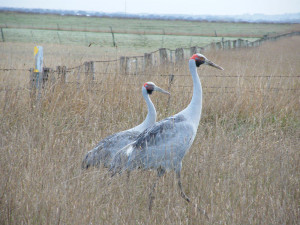BOLSTERING THE BROLGA
Informing future conservation planning for the native Brolga (Grus rubicunda) in South Eastern Australia through applied genetic research

The Brolga
The Brolga (Grus rubicunda) is an iconic crane species in our landscape, creating an evocative image as pairs dance together at dawn and dusk around our local wetlands. The species has a broad distribution including the far north (Northern Territory and Queensland) and south east of Australia (south western Victoria and South eastern South Australia). However, over the last three decades the southern population has declined severely primarily as a result of habitat fragmentation and degradation, and predation by foxes. It is estimated that only 200-250 nesting pairs remain, highlighting the need for further information on the species biology and ecology to better understand reasons for its decline and to ensure the birds’ future.
NGT and The University of Melbourne are seeking your help to fund an investigation into the genetic status of the southern Brolga population. Currently there is some uncertainty surrounding the connectivity of the northern and southern Brolga populations, and even if they are in fact the same species. If the southern Brolga population is determined to be genetically distinct, its conservation status in Victoria is likely to move from ‘threatened’ to ‘critically endangered’, increasing the urgency of its protection.
The genetic study will also help confirm the findings of a recent GPS tracking study by the University of Ballarat and The University of Melbourne, that demonstrated limited individual bird movement and the potential existence of isolated breeding populations in south west Victoria. These findings spell bad news for the southern Brolga, suggesting that local population sizes are critically low and the species even more vulnerable than currently assumed. The genetic study will clarify these findings by providing a detailed estimate of population structure through the assessment of breeding relationships among birds from both the southeast and northeast of Australia. It will also help identify critically important refuge wetland habitats for protection in order to conserve resident populations.
The information gained from the genetic study will provide both government and industry with the necessary information needed to maximise the species’ chance of survival, identify critical habitat for protection, and minimise risks associated with land-use activities. With your help we can undertake this important project to secure the Brolgas future, and provide future generations with the opportunity to witness these iconic wetland birds. If you want further details about this project please contact NGT, and to find out more about the previous Brolga project please refer to http://victorianbrolgastudy.com.au/)

